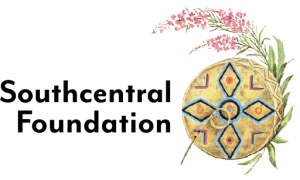Reducing Teen Substance Use Through Strength-based Practices and Harm-reduction Principles
By Public Relations Specialist Levi Oyster
Adolescent youth face many challenges today, including access to harmful substances. By offering guidance, connection to culture, and an ear to listen, we can make a difference and help build resiliency amongst youth. Substance use in youth is a public health concern affecting communities throughout Alaska. One in five American Indian and Alaska Native young adults, aged 18-25 years, has a substance use disorder, including 10% with alcohol and 11% with illicit substances.

Adolescents gain strength through culture and mindful practices.
“Alcohol and marijuana are the most prevalent substances misused by youth, but other substances are making inroads into rural communities, including methamphetamine, cocaine, and most recently, fentanyl,” Southcentral Foundation Rural Behavioral Health Clinician Jim Henkelman shared. “Of particular concern is the influx of fake pills, fentanyl-laden pills, made to look like other regular medications.”
SCF offers integrated substance use and behavioral health services for youth and their families. This initiative to support customer-owners is implemented with strength-based practices and harm-reduction principles through many different services.
Strength-based practices encourage building resiliency to navigate everyday problems and find healthy solutions.
“We collaborate with customer-owners to treat the whole person, including their mind, body, spirit, culture, and community,” The Pathway Home Clinical Supervisor Josh Goldstein said. “Identifying strengths is built into our treatment plans, intake assessments, and regular care team feedback meetings with customer-owners.”
The Pathway Home is a long-term residential treatment program that serves adolescents from 13 to 18 years with emotional and behavioral problems but also works with teens on their substance use recovery journeys. In individual and group settings, teens learn behavior and anger management, conflict resolution, and other healthy coping skills in a trauma-informed environment.
“Customer-owners engage in cultural activities, community service, recreation therapy, outdoor education, and social connectedness to identify new skills and tools,” Goldstein explained.
The stigmas surrounding substance use can be a barrier to recovery and seeking help.
“We adopt evidence-based practices that support prevention through education, as we believe that realistic, informed decision-making leads to safer outcomes,” Goldstein stated. “Customer-owners have the option, with caregiver consent, to become trained naloxone administrators and learn to use fentanyl test strip kits. In this way, customer-owners can bring harm prevention and safety tools back to their home communities.”
Instead of ignoring or condemning substance use, customer-owners are informed of the tragic harm and dangers that can come from the misuse of substances.
“Recently, I worked with a customer-owner using the harm reduction model, and he cut back significantly on his usage,” Henkelman expressed. “Then he preferred the feeling of being sober and wanted to go the complete abstinence route. It was his processing this and coming to that decision on his own, which is supporting his success.”
Harm-reduction principles are a way of meeting people where they are by recognizing the realities of trauma, poverty, social inequalities, and other adverse life circumstances.
For more information on substance-use treatment and prevention, contact your primary care team to schedule an appointment with a behavioral health consultant.


